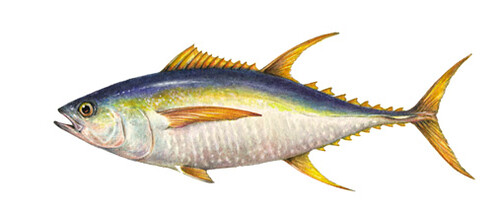Note from Beth: I’ve been looking for good examples of nonprofit mobile strategies. I had to look no further than the Monterey Bay Aquarium’s Seafood Watch Program. With 75% of the world’s fisheries are fished to capacity, or overfished, the fish we order in restaurants or pick up at the grocery store for dinner, has the power to make this situation worse, or improve it. But, as consumers, we don’t have that information handy, unless the the restaurant specifically lets us know and, of course, there is an agreed upon standard for us to determine what is sustainable and what isn’t. So, this is the very important information that the Seafood Watch Program provides people like me, someone who loves to each seafood, but wants to do it in a responsible way. Before we relied heavily on our cell phones, the program offers small paper guides. So, moving to a mobile phone app makes sense for Seafood watch, so they can catch consumers at the point of decision-making.
I wanted to find out more about how Seafood Watch integrates its mobile strategy across its communications channel, including social media. Also, given the different benefits and limitations of different mobile platforms, I wanted to learn more about how they navigate different mobile platforms. Humberto Kam, Senior Manager of Online Communications for the Monterey Bay Aquarium, was kind enough sit down for an interview recently.
Tell me about Seafood Watch. What are the program goals?
The Monterey Bay Aquarium’s Seafood Watch program works to transform seafood markets in ways that create incentives for sustainable fishing and fish-farming practices. Its main efforts involve working with major seafood buyers to help them shift their purchases to more sustainable options, and with consumers to raise awareness about the connection between the seafood they eat and the health of the oceans, and to create grassroots support for sustainable seafood. We also work with food service companies, retailers and wholesalers, chefs and restaurateurs to encourage them to make the switch to sustainable seafood.
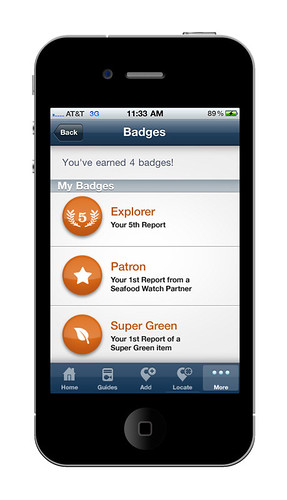
(Your organization was one of the early adopters of mobile phone apps. When and why did you implement your first Seafood Watch App? What were some of the results?
The original Seafood Watch iPhone app was released in January 2009. Resident apps help us put the most up-to-date information in the hands of users, since our consumer seafood recommendations are updated twice a year. Before that, we’d heard stories of people carrying dog-eared copies of an old – outdated – paper pocket guide. While you may not always have the most current pocket guide with you, you certainly never leave home without your phone. We also designed the app so it doesn’t rely on an internet connection, since that romantic little spot by the beach might have lousy reception. Finally, as a conservation organization, we’re always looking at ways to reduce our use of paper.
The Seafood Watch app has been downloaded by more than 480,000 people. It’s won awards from Treehugger.com as the “Best of Green in Food and Health” and is cited regularly in mainstream and new media as a trusted source for sustainable seafood information.
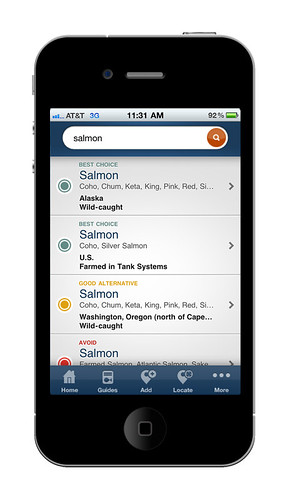
You’ve just launched a new version of Seafood Watch. What is different?mIs the app the only component of your mobile strategy?
The biggest change to the most recent Seafood Watch app is Project FishMap, a crowdsourced effort to help people find ocean-friendly seafood, no matter where they live. People can tag any of more than one million restaurants and markets across the United States when they find ocean-friendly seafood. Users can also add restaurants and retailers that sell sustainable seafood if they don’t find them listed in our database. And other people can search the location-based database to find sustainable seafood nearby.
We’re also experimenting with the introduction of game mechanics. Each time someone adds a seafood item, they can earn virtual badges (first sushi report, first listing of a particular seafood item). With Project FishMap, anyone who finds sustainable seafood can share their discoveries. Each time they do, they’re helping others make better seafood choices.
We’ve also improved search functions that help people find seafood quickly and easily by its common market name or, in the case of sushi, by its Japanese name. We’ve added suggestions for sustainable alternatives to items on the Seafood Watch “Avoid” list, and have highlighted a list of “Super Green” seafood that is heart-healthy, low in contaminants, and caught or farmed in ways that are good for the oceans.
The iPhone app is only part of strategy to use mobile technology to get the sustainable seafood message and information as close as we can to the decision point – that is, at the restaurant or seafood counter. We launched a mobile site, in 2007 aimed at feature phones, and we’re developing an Android version of the app for release in 2011. Additionally, in an upcoming version of the app we’ll be pushing sustainable seafood information to users who’ve downloaded the app.
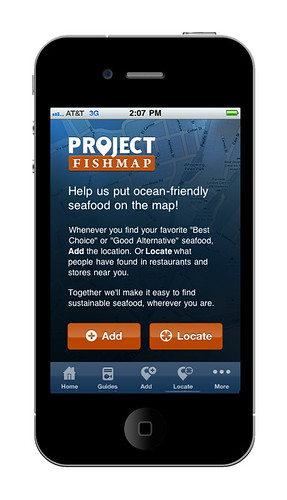
How will you measure success? What metrics are you using for mobile?
We’ll be looking at downloads and usage, since our goal is to create an app that is so useful that it becomes a part of people’s toolkit for green living. For Project FishMap we’ll look at how many people are reporting locations where they find sustainable seafood – restaurants, retailers, cities. In the first month almost 500 people made over 2,500 reports in 270 cities. We’ll also be looking at how many people, out of all those who use the app, become Project FishMap users and contributors. As with any project like this, we expect that most of the data will come from a few dedicated individuals, but we’re taken great pains to make it simple for people to participate and provide another way for people to support the cause.
What is your overall communication strategy for Seafood Watch? It looks like you are taking an integrating approach – web, print, main stream media, social media, and mobile. Can you tell me how the channels support and enhance each other?
We do take an integrated approach to our communications. The Pocket Guides are a great resource and conversation starters. They’re an easy way to engage people and lead them to our website to learn more about the program. They’re also a great story to share with the media, whether it’s mainstream print and broadcast outlets, or the growing number of websites and blogs devoted to green living and food issues.
Our website, is the hub for all in-depth information and news. But we can’t rely on people to come to our site wondering what’s new, or to find us by chance. That’s where email and social media come in, so users can opt to get more information from us about what’s new on the issue of sustainable seafood. We want people to sign up to hear from us in any and all ways they would like and use those channels – email, Facebook, Twitter being the most popular channels. We want to keep sustainable seafood top of mind, and drive people to our site and blog for more information. And as more and more of those emails, tweets and posts are read on the go we need to make sure they are mobile-friendly.
What advice would you offer to other nonprofits about using mobile apps as part of their overall communications strategy?
The biggest piece of advice is “be useful.” An app is not another form of email or social media channel. For an organization, it can give you a way to communicate with users who care about your issue. But you need to give them something useful if you want to stay on their phone, and keep your issue relevant to their lives and values.
These days, useful also means context aware. How can you deliver information or services that take into consideration the user’s preferences, needs, or location? It’s great to let them know they should be eating troll- or hook-and-line caught yellowfin tuna from the Atlantic. But where can they find a restaurant that serves it? Even better, where can they find it near where they are – right now? Also remember that no matter how smart your smartphone is, at its core it’s a communication device. Tap into their contact list, make it easy for them to make a call, tweet or Facebook their support for your cause.
Tell us more about your decision to invest in Android Platform. Will it have fundraising?
Android is such a growing presence on the mobile landscape that we’d be remiss if we didn’t create an Android version of the app. “Is there an Android version?” is by far the number one question we get by email, Twitter and Facebook when we talk about our app. Additionally, with a crowdsourced initiative like Project FishMap we need to make it widely available quickly. To get the Android version to market as soon as possible, we decided to not add any features for this initial release. We’ll then evaluate if it’s something we should include in a future release.
My other question about strategy is about conversion — clearly the Seafood Guide mobile platform is for people who are out buying fish or ordering in a restaurant – and it is convenient to look up. Is there any conversion strategy to get those people as advocates or donors?
In the app we give users the option to sign up for our email newsletter which regularly features ways in which people can support our mission. Additionally, an upcoming version of the app will feature a “What’s New” feed that will have sustainable seafood news and additional ways to become involved and support our mission.
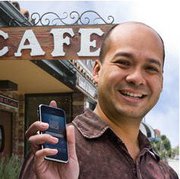
Humberto Kam is Senior Manager of Online Communications for the Monterey Bay Aquarium, where he is responsible for the Aquarium’s online initiatives. Prior to the Aquarium, he worked for The Walt Disney Company creating games that bridged the online and theme park experiences.
